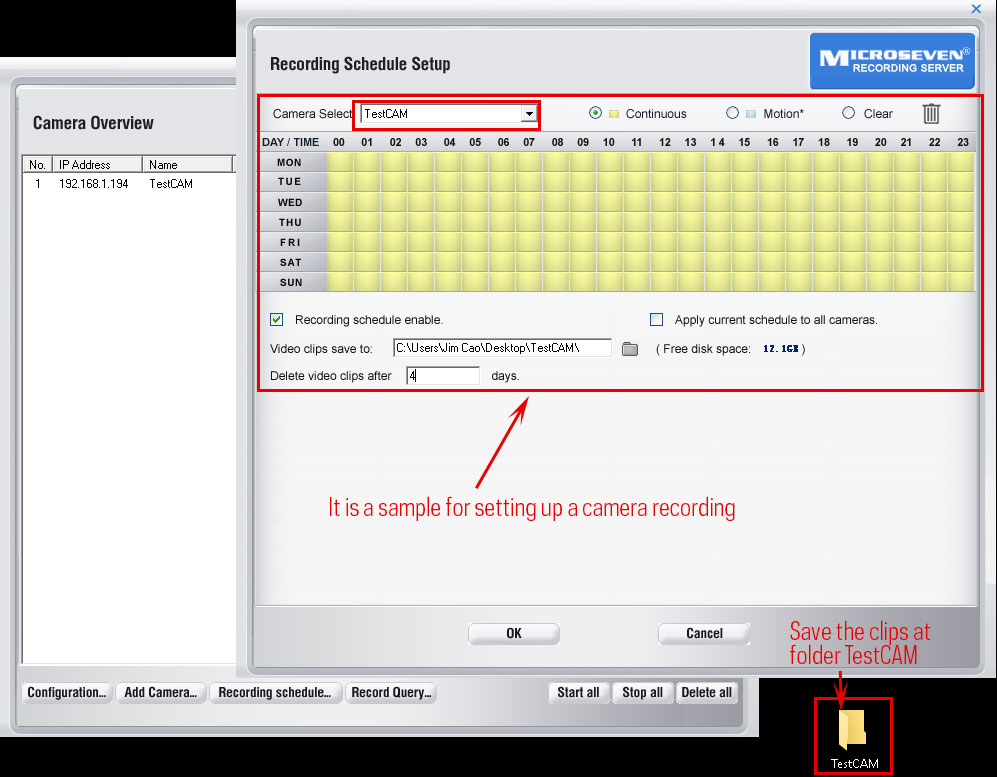

- #Microseven delete selected videos install#
- #Microseven delete selected videos driver#
- #Microseven delete selected videos manual#
- #Microseven delete selected videos password#
- #Microseven delete selected videos download#
Do not set the computer IP to the same number as the device ID. Set the computers IP to any number on the 10.0.0 subnet, for example 10.0.0.57 or 10.0.0.24. The Cam Locator will state the device IP address and thus the subnet the device is on. Once there set the network to a 10.0.0 subnet, which should be the same net as the camera. Click on the new ethernet connection and click on properties and then (TCP/IPv4). Once there you should see an ethernet connection along with any other internet connections. Go to Control Panel -> Network and Internet -> Network and Sharing Center. Here are the configuration settings for Windows to enable TCP/IP communication.
#Microseven delete selected videos manual#
If it does not, go to the respective TCP/IP configuration manual below for your respective OS.
#Microseven delete selected videos password#
If it does enter the username and password which have the default setting of Username-admin password=password respectively. This will most likely not work as your computer needs to be configured to communicate with the camera via TCP/IP. The device type will always start with MYM7, you can try to open the camera by double clicking on the device in the cam locator. Press search and locate your device and the device ID. Once you have your computer and TCW hardware properly set-up, open the camera locator application that you downloaded. Once you have downloaded the software, setup the camera using the hardware instructions in this manual.
#Microseven delete selected videos download#
The exact files to download are shown below. Then click on the correct version for your computer, it runs on either Windows or MacOS.
#Microseven delete selected videos install#
To install your MicroSeven Webcam software navigate to hover over downloads and click on firmware and software. If you have only shielded cables, use them, and if you find the cameras are rebooting themselves, or stalling, every now and then, buy some unshielded cables and try them instead. If you use a shielded cable instead of an unshielded cable, it is unlikely you will experience any problems with ground loops, but it is possible. The unshielded cable from the Faraday enclosure wall to the PoE switch guarantees that there will be no ground loops created by the various webcam cables. The shielded cable within the enclosure is necessary to minimise the transmission of noise by the ethernet signals, which can otherwise disturb reception of our telemetry signals. We recommend an unshielded cable from the PoE switch to the ethernet feedthrough, then a shielded cable from the feedthrough to the cable provided by the camera.

A black unshielded ethernet cable connects to a PoE switch. The other end of the blue cable connects to an ethernet feedthrough, which is visible behind the white dome of the camera. This webcam provides a white cable into which we plug a blue, shielded ethernet cable. In the photograph below we see a free-hanging ethernet feedthrough connecting the blue and black ethernet cables that make the connection between the PoE switch and the webcam.įigure: Cable Connections for a Telemetry-Compatible Webcam (TCW1B). We place the camera inside a Faraday enclosure and connect it to an ethernet feedthrough in the enclosure wall. It requires only one ethernet cable connection for power and communication. The TCW is a Power-over-Ethernet (PoE) webcam. The sticker shows that we have opened the box, checked and tested the camera, inserted the correct cables, and sealed it again. The box shows the model numbewr and manufacturer of the camera. We package each TCW with the cable you need to connect it to the wall of a Faraday enclosure, and from the wall to the PoE switch.įigure: Telemetry-Compatible Webcam (TCW1B) in Box. We can connect multiple TCWs to the same PoE switch as our telemetry receivers and data acquisition computer.
#Microseven delete selected videos driver#
The LWDAQ Driver is in turn connected to an Octal Data Receiver for telemetry reception. They are just as convenient to use as our ACCs, in that they are Power over Ethernet (PoE) devices that require only one ethernet cable for power and communication.įigure: Telemetry Compatible Webcam Connected to PoE Switch Along with LWDAQ Driver and Data Acquisition Computer. We guarantee that they will not disturb your SCT recordings. Our TCW cameras are models we have tested with our SCT system, and for which we have measured microwave power radiation with our own instruments. We supply the camera with a short, shielded network cable and a long, unshielded netrok cable.Ĭommercially-available webcams can distrupt reception of our subcutaneous transmitter (SCT) signals. The camera itself is manufactured by MicroSeven. The TCW is a fraction of the cost of an ACC, but the synchronization it provides is no better than a ☖0 s, compared to the ACC's ☑00 ms.įigure: Telemetry-Compatible Webcam (TCW1B). Our Telemetry-Compatible Webcams (TCWs) are an alternative to our Animal Cage Cameras ( ACCs). Telemetry-Compatible Webcams Telemetry-Compatible Webcams


 0 kommentar(er)
0 kommentar(er)
